Germany OTC Drug Market Size
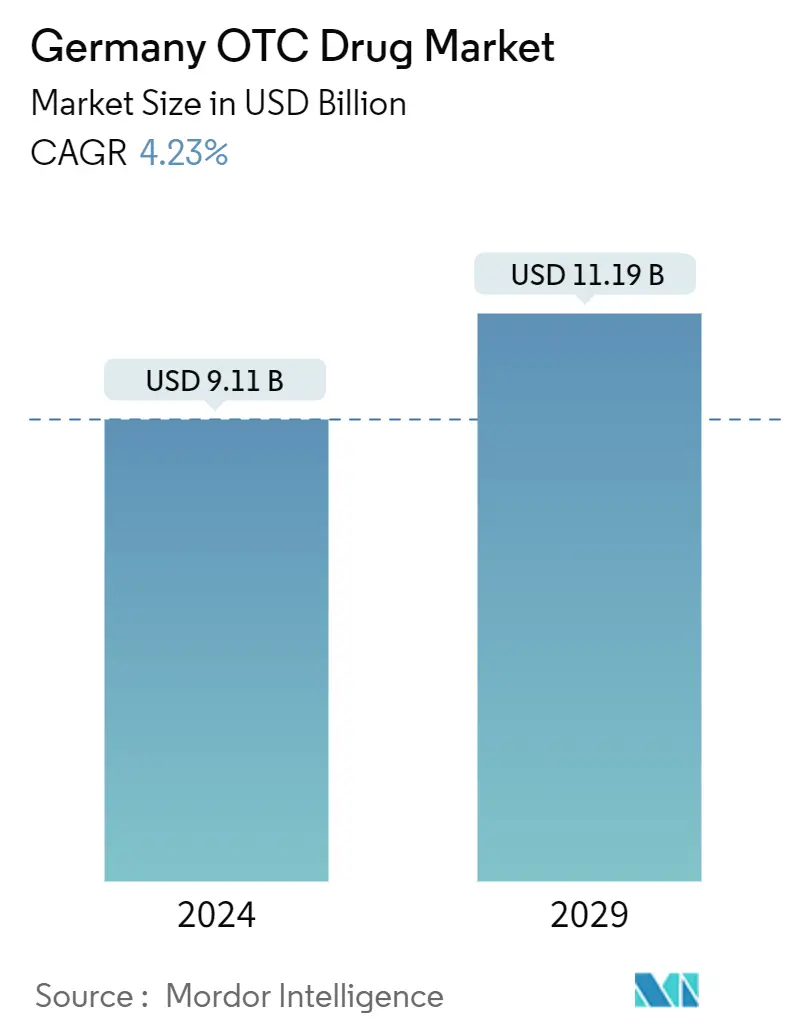
| Study Period | 2019-2029 |
| Base Year For Estimation | 2023 |
| Market Size (2024) | USD 9.11 Billion |
| Market Size (2029) | USD 11.19 Billion |
| CAGR (2024 - 2029) | 4.23 % |
| Market Concentration | Medium |
Major Players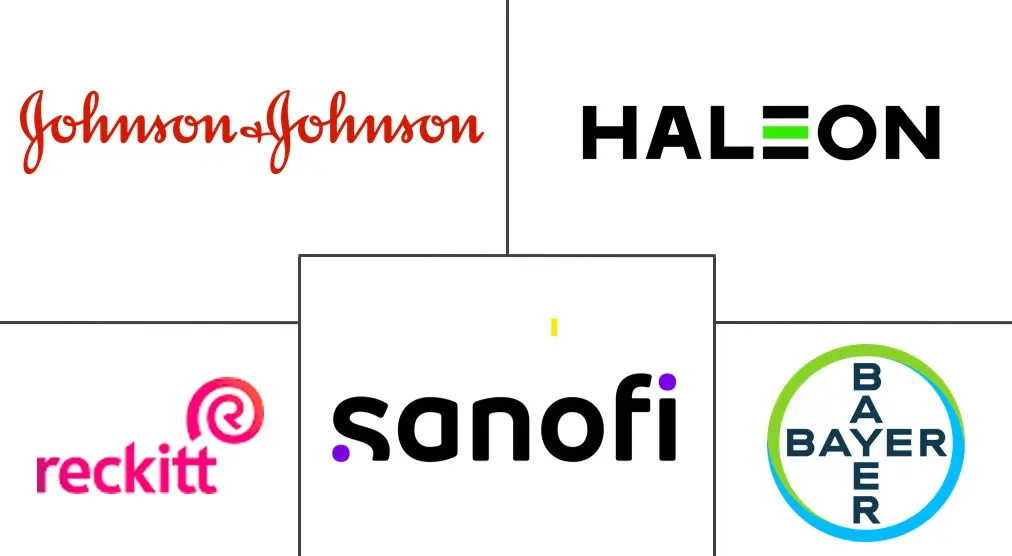
*Disclaimer: Major Players sorted in no particular order |
Germany OTC Drug Market Analysis
The Germany OTC Drug Market size is estimated at USD 9.11 billion in 2024, and is expected to reach USD 11.19 billion by 2029, growing at a CAGR of 4.23% during the forecast period (2024-2029).
Amidst the initial phase of the COVID-19 pandemic, over-the-counter (OTC) medicines were in high demand due to limited visits to hospitals and clinics. Due to a lack of medical assistance for general medical ailments, the use of telemedicine among the Germans for self-medication using analgesics, cough, cold, & flu products, vitamin, mineral, and supplement (VMS) products, and dermatology products became increasingly popular as a temporary solution. Therefore, initially, the market growth was impacted due to supply chain disruptions and shortages of drugs owing to the nationwide lockdowns and trade restrictions, and the market is expected to stabilize in the near future.
Furthermore, the major factors propelling the growth of the German OTC drug market include product innovation, expanding distribution channels, pharmaceutical companies' shift from Rx to OTC drugs, and rising self-medication among Germans. Increasing healthcare costs demand better accessibility and affordability of healthcare services. Self-medication with non-prescription drugs has increased in the past years owing to its advantages, such as helping improve the accessibility and cost benefits of healthcare services. Thus, the country witnessed a shift in the trend toward self-medication. For instance, according to the report published by the University of Germany in February 2023, the German population's annual spending on over-the-counter medicines amounts to around EUR 6 billion (USD 6.3 billion). Almost four-fifths of this amount is spent on self-medication drugs. Thus, such factors are likely to boost the adoption of OTC drugs, thereby propelling the market's growth.
In addition, according to the data updated by the Association of the European Self-medication Industry in 2021/2022, non-prescription medicinal products account for one out of every two packages of medicines sold in Germany. The widespread use of over-the-counter medications has been linked to significant cost savings for healthcare providers. As a result, all of these factors above are estimated to increase the demand for OTC products in the country, which is expected to drive the market's growth.
However, incorrect self-diagnosis and the probability of OTC drug abuse may hinder the growth of the market.
Germany OTC Drug Market Trends
Cough, Cold, and Flu Products Segment is Expected to Garner a Significant Share in the Market Over the Forecast Period
The rise in the number of people affected by cough, cold, and flu, especially among the elderly population, is driving the demand for over-the-counter (OTC) drugs for this segment. The elderly patients' shifting preference toward OTC drugs to treat common diseases such as colds and flu owing to their ready availability at pharmacies without a doctor's prescription is likely to have a positive impact on the segment's growth.
According to the report published by the Robert Koch Institute (RKI) in October 2022, more than 2,100 cases of influenza were reported in a week and a total of around 8,330 since the start of the season in October. In addition, a large number of reports came from Bavaria and North Rhine-Westphalia. This showed the high burden of influenza cases, which causes the common cold. It was expected to increase the demand for its management using OTC medicines and likely boost the market over the study period.
The increasing awareness of OTC drugs through campaigns and easy access to these medicines is expected to drive the segment growth over the study period. For instance, in April 2022, STADA bundled its over-the-counter generic products in a uniform blue design and supported pharmacies with comprehensive services for advice, placement, and regional strengthening of sales. A new campaign was developed with the slogan “STADA is always there” to make a wide range of over-the-counter consumer health products, which include cold medicines. These campaigns help to increase the effective use of cold, cough, and flu drugs, which will likely propel the segment growth over the forecast period.
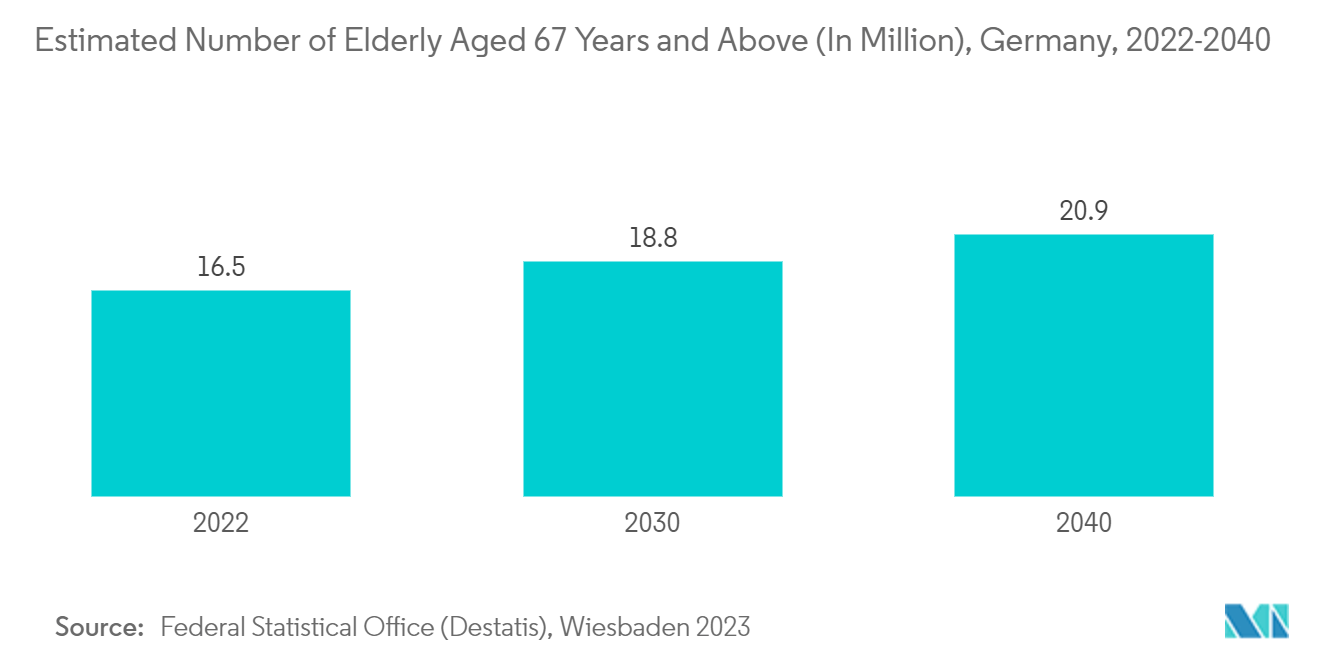
Online Pharmacies Segment is Expected to Register High CAGR in the Market Over the Forecast Period
A pharmacy that uses the Internet to conduct business and delivers orders to consumers via mail, shipping services, or an online pharmacy web portal is known as an online pharmacy, internet pharmacy, or mail-order pharmacy. In addition, the growing elderly population is expected to increase the usage of E-pharmacy services, which reduces the burden of traveling to retail pharmacies and drives the market to grow. Furthermore, due to the new initiatives of the government in E-pharmacies, the market is expected to have significant growth over the forecast period.
For instance, in September 2022, the Federal Ministry of Health Germany stated that pharmacies throughout Germany have been able to redeem e-prescriptions and settle accounts with health insurance companies. In addition, if non-prescription medicines are prescribed for self-payers with statutory health insurance, this corresponds to a green prescription. Hence, pharmacy-only medicines can also be procured by using green prescriptions, which are expected to boost the growth of the segment over the study period.
Furthermore, the company's strategic activities, like acquisitions and collaborations, are expected to drive market growth in the country. For instance, in February 2022, DOUGLAS acquired the Dutch online pharmacy disapo.de to enter the high-growth online pharmacy market. The launch was planned initially in Germany with over-the-counter (OTC) medicines. Hence, the new company's strategic activities increase the widespread distribution of products in the country and are expected to propel the segment growth over the forecast period.
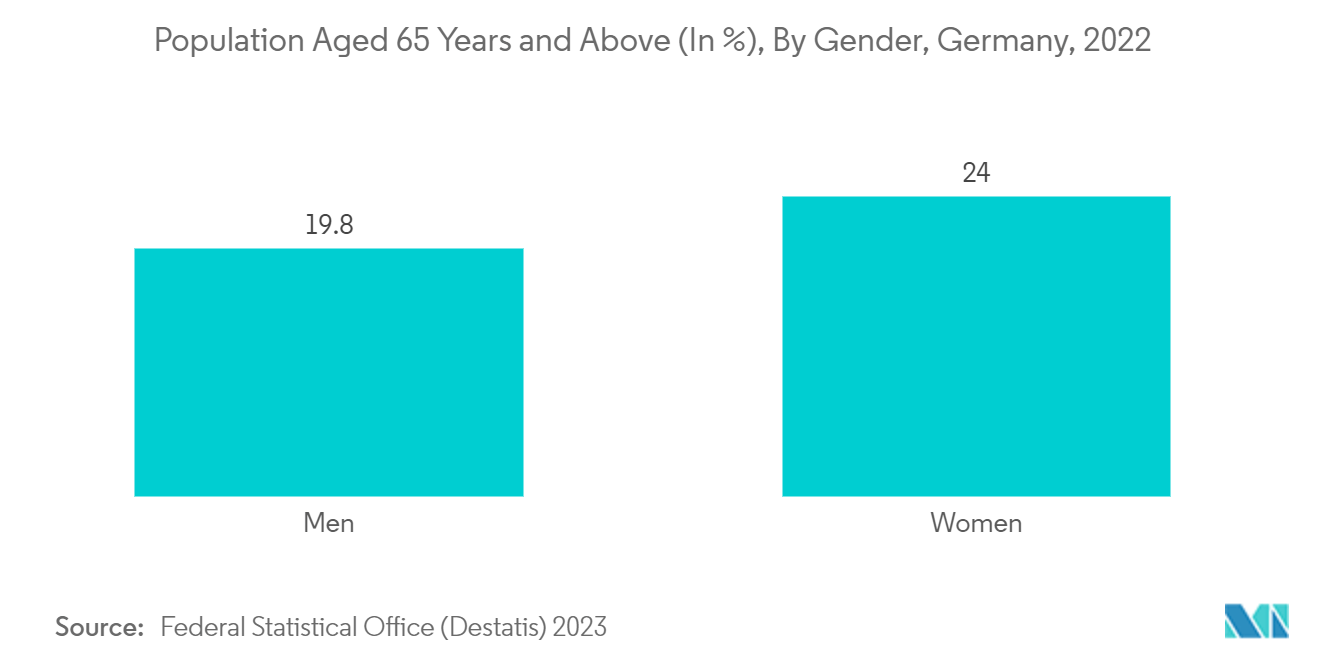
Germany OTC Drug Industry Overview
The German over-the-counter (OTC) drug market is highly competitive. Some major players are holding the major share, along with some smaller companies holding a substantial share. However, with product innovations, mid-size to smaller companies are increasing their market presence by introducing new products at lower prices. Key players in the market are Bayer, Pfizer Inc., Sanofi SA, Haleon Group of Companies, and Reckitt Benckiser Group PLC, among others.
Germany OTC Drug Market Leaders
-
Bayer AG
-
Sanofi SA
-
Johnson & Johnson
-
Reckitt Benckiser Group PLC
-
Haleon Group of Companies
*Disclaimer: Major Players sorted in no particular order
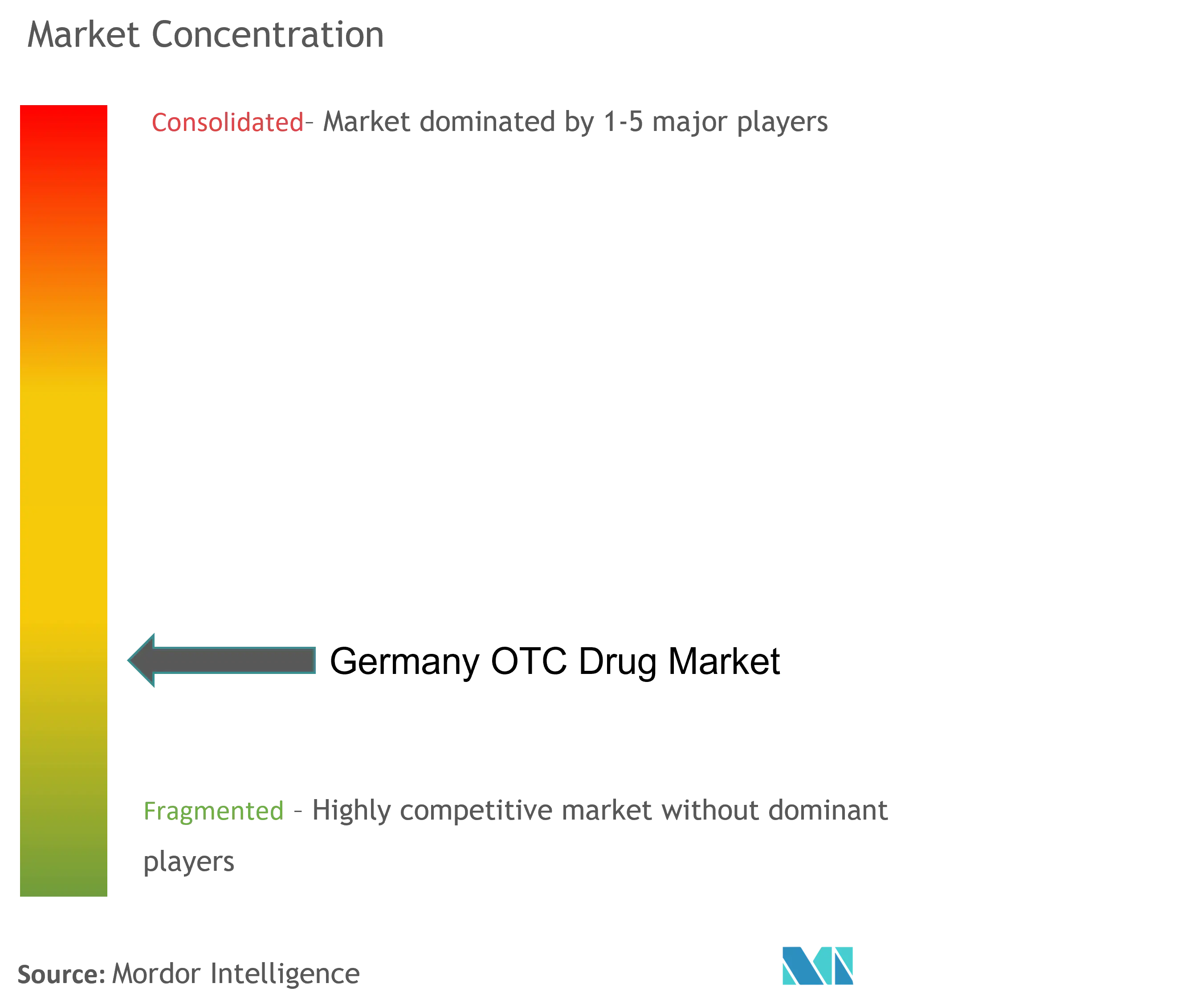
Germany OTC Drug Market News
- July 2022: GSK plc completed the demerger of the Consumer Healthcare business from the GSK Group to form the Haleon Group. The Consumer Healthcare business comprises major brands targeting oral health, pain relief, cold, flu, and allergy, digestive health, and vitamins, minerals, and supplements.
- February 2022: Douglas purchased Disapo in order to enter the high-growth online pharmacy market in Germany, starting with over-the-counter (OTC) medicines, which will be offered, sold, and shipped independently through Disapo on the Douglas marketplace.
Germany OTC Drug Market Report - Table of Contents
1. INTRODUCTION
- 1.1 Study Assumptions and Market Definition
- 1.2 Scope of the Study
2. RESEARCH METHODOLOGY
3. EXECUTIVE SUMMARY
4. MARKET DYNAMICS
- 4.1 Market Overview
-
4.2 Market Drivers
- 4.2.1 Inclination of Pharmaceutical Companies to Switch From Rx to OTC Drugs
- 4.2.2 Increasing Self Medication Among the General Population
-
4.3 Market Restraints
- 4.3.1 Incorrect Self Diagnosis and High Probability of OTC Drug Abuse
-
4.4 Porter's Five Forces Analysis
- 4.4.1 Bargaining Power of Suppliers
- 4.4.2 Bargaining Power of Buyers/Consumers
- 4.4.3 Threat of New Entrants
- 4.4.4 Threat of Substitute Products
- 4.4.5 Intensity of Competitive Rivalry
5. MARKET SEGMENTATION (Market Size by Value – USD)
-
5.1 By Products
- 5.1.1 Cough, Cold, and Flu Products
- 5.1.2 Analgesics
- 5.1.3 Dermatology Products
- 5.1.4 Gastrointestinal Products
- 5.1.5 Vitamin, Mineral, and Supplement (VMS) Products
- 5.1.6 Weight-loss/Dietary Products
- 5.1.7 Ophthalmic Products
- 5.1.8 Sleeping Aids
- 5.1.9 Other Product Types
-
5.2 By Distribution Channels
- 5.2.1 Retail Pharmacies
- 5.2.2 Online Pharmacies
- 5.2.3 Other Distribution Channels
6. COMPETITIVE LANDSCAPE
-
6.1 Company Profiles
- 6.1.1 Astrazeneca PLC
- 6.1.2 Bayer
- 6.1.3 Bristol-Myers Squibb
- 6.1.4 Cardinal Health
- 6.1.5 Haleon Group of Companies
- 6.1.6 Johnson and Johnso
- 6.1.7 Leo Pharma AS
- 6.1.8 Procter & Gamble ( Merck & Co.)
- 6.1.9 Novartis AG
- 6.1.10 Pfizer Inc.
- 6.1.11 Reckitt Benckiser Group PLC
- 6.1.12 Sanofi SA
- 6.1.13 Takeda Pharamaceutical Company Ltd
- *List Not Exhaustive
7. MARKET OPPORTUNITIES AND FUTURE TRENDS
** Subject To AvailablityGermany OTC Drug Industry Segmentation
As per the scope of this report, over-the-counter (OTC) drugs are referred to as nonprescription drugs. These medicines can be bought by individuals without a doctor’s prescription and are safe for consumption without the doctor’s consent.
The German OTC drug market is segmented by products (cough, cold, and flu products, analgesics, dermatology products, gastrointestinal products, vitamin, mineral, and supplement (VMS) products, weight-loss/dietary products, ophthalmic products, sleeping aids, and other product types) and distribution channels (retail pharmacies, online pharmacies, and other distribution channels).
The report offers the value (in USD) for the above segments.
| By Products | Cough, Cold, and Flu Products |
| Analgesics | |
| Dermatology Products | |
| Gastrointestinal Products | |
| Vitamin, Mineral, and Supplement (VMS) Products | |
| Weight-loss/Dietary Products | |
| Ophthalmic Products | |
| Sleeping Aids | |
| Other Product Types | |
| By Distribution Channels | Retail Pharmacies |
| Online Pharmacies | |
| Other Distribution Channels |
Germany OTC Drug Market Research FAQs
How big is the Germany OTC Drug Market?
The Germany OTC Drug Market size is expected to reach USD 9.11 billion in 2024 and grow at a CAGR of 4.23% to reach USD 11.19 billion by 2029.
What is the current Germany OTC Drug Market size?
In 2024, the Germany OTC Drug Market size is expected to reach USD 9.11 billion.
Who are the key players in Germany OTC Drug Market?
Bayer AG, Sanofi SA, Johnson & Johnson, Reckitt Benckiser Group PLC and Haleon Group of Companies are the major companies operating in the Germany OTC Drug Market.
What years does this Germany OTC Drug Market cover, and what was the market size in 2023?
In 2023, the Germany OTC Drug Market size was estimated at USD 8.72 billion. The report covers the Germany OTC Drug Market historical market size for years: 2019, 2020, 2021, 2022 and 2023. The report also forecasts the Germany OTC Drug Market size for years: 2024, 2025, 2026, 2027, 2028 and 2029.
Germany OTC Drug Industry Report
Statistics for the 2024 Germany OTC Drug market share, size and revenue growth rate, created by Mordor Intelligence™ Industry Reports. Germany OTC Drug analysis includes a market forecast outlook to 2029 and historical overview. Get a sample of this industry analysis as a free report PDF download.



